ATI The Alliance for Traffic Improvement
Seeking cost effective ways to reduce traffic congestion on Oahu
![]() February 27, 2005.
February 27, 2005.
A
Great op/ed by Dale Evans today
Dale Evans, Head of Charley's Taxi and the Hawaii Highway Users
Alliance, wrote a great piece in the Advertiser today outlining
our position against rail and for HOT lanes. It's a two parter with
Karl Kim, professor of urban and regional planning at the University of Hawai'i-Manoa. Kim's
is first and Dale's piece follows it. READ MORE
![]() February 26, 2005.
February 26, 2005.
Again:
Winners are always those who show up. Be there!
As
the Tax Foundation and the Advertiser are saying, it will cost $900
per family annually to build rail. But that does not include the
subsidies necessary to operate it. According to the 1992 FEIS, p.
6-6, that would have been $45 million annually. Allowing for inflation
that amounts $57 million in today's money, or $265 per family of
four annually to add to the $900. To stop this kind of nonsense
it is worth getting out early for the demonstration. Right?
LATE
NOTE: National Weather Service forecast for Monday...Sunny. Highs 77 to 83. East winds 10 to 15 mph
![]() February 26, 2005.
February 26, 2005.
DEMONSTRATION:
Winners are always those who show up. Be there!
A
reminder that the demonstration is Monday morning early. See below
for details.
The image below is a rendering made by the American
Institute of Architects, Hawaii Chapter in 1992 of the rail line
along Nimitz.
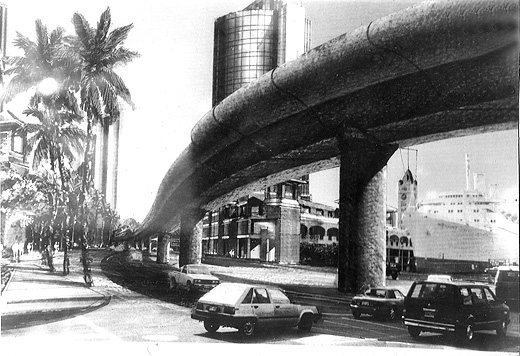
Lee
Cataluna speaks out on taxes and spending:
She
talks about politicians who, "look straight into the camera
and tell us we NEED to have whatever they're up to." It's
surely the truth about rail transit and campaign contributions.
READ MORE
![]() February 25, 2005.
February 25, 2005.
Demonstration
against rail tax on Monday; be there:
This
Monday morning, February 28, from 7:30am
to 8:30am, members of The Alliance for Traffic Improvement (ATI) and
supporters, including the League of Women Voters and Small Business Hawaii
among others, will picket the Mission Memorial Auditorium to protest the
proposed 25 percent tax hike in the G.E. tax from four to five percent to pay
for a rail transit line.
We will picket the “
We will provide signs and for parking READ
MORE
![]() February 23, 2005.
February 23, 2005.
Nation's
leading consultants blast the rail idea
In
1990, the state government selected eleven nationally recognized
academic experts to examine the EIS for the rail line and comment
on it. UH staffers assembled their responses, summarized it, then
printed the resulting document. It was a bombshell; the eleven experts
criticized virtually everything in the plan. Since state and city
officials have said they are going to bring the old FEIS up to date
and others have said the early 1990's proposal will be the basis
of a new one, it is essential that everyone understand the report's
contents. The full report itself is available at various libraries
in town. Here we present a few of the more choice comments. READ
MORE
![]() February 20, 2005.
February 20, 2005.
Leading
tax attorney blasts the rail tax proposal
Ronald
I. Heller, a leading tax attorney and Chair of NFIB's Hawaii
Leadership Council, discusses the additional county tax for rail
as being bad for the state for eight different reasons. We are already
rated dead last on the U.S. Tax Foundation's Business Tax Climate Index
(see story yesterday) and we pay the fourth highest per capita
taxes in the nation. And they want to raise taxes? READ MORE
AP:
Houston's light rail making a real dent in city's car
traffic
When we first read this
headline from the Associated Press in the Seattle Times on line,
we were taken aback. But they were discussing the more than 50 collisions
with automobiles that Houston's light rail has had in just nine
months — it's now known locally as the Wham-Bam-Tram. READ MORE
Update: The
Last Word On Rail Transit:
Rail
transit forecasts for ridership are normally for 20-25 years in
the future and they usually
forecast a 50 percent increase in the percentage of commuters that
will use
public transportation.
However, we can look back 20 years and see
what happened in the 22 U.S. metro areas with rail transit since
most of the rail transit lines opened between the 1980
and 2000 Censuses.
The Census data shows us that the percentage of
commuters using public transportation
declined in all but one of them — San
Diego — and it only held its own. All the other 21 metro areas with rail, saw
a decline.
On the other hand, four of the metro areas that did not have
rail, increased their percentage.
Get the federal data from us
at the ATI
SITE or the Federal Highway Administration
site.(FHWA) (Look
for page 4-9 in Chapter 4).
![]() February 19, 2005.
February 19, 2005.
New
group backs rail transit:
The
Committee for Balanced Transportation with Roger Morton of TheBus,
Wes Frystecki a longtime City consultant are running things. They
accuse opponents of "fictions." We
have answered them.
READ MORE
Rail
tax bill does not allow filling Harris holes:
House
Bill 1309 which will enable the counties to increase the GE tax
for rail transit for The county surcharge on state tax shall not be used to build or repair public
roads or highways," says House Bill 1309. READ MORE
Update
on the OMPO rail tax survey:
Since
officials have been touting the public approval of the rail tax,
we decided to take another look at it. The poll was taken in September
before the BRT began service; 70 percent of those polled thought
that BRT would be an improvement. Wonder what they would think today.
READ MORE
U.S.
Tax Foundation rates Hawaii dead last:
The
Foundation's Business Tax Climate Index rates us at the bottom of
all states. READ MORE
![]() February 16, 2005.
February 16, 2005.
Let's
try other taxes for rail:
Legislators
are looking to allow Honolulu's City Council to raise the GE Tax
one percent to pay for rail. But that is a regressive tax falling
unfairly on the less affluent. Instead, since motorists will benefit
by lessened congestion, let them pay for it with a $1.34 increase
in the City gasoline tax. Or, failing that, we could boost property
taxes — about 60 percent would be enough — so that the taxes
on a $500,000 house would go from $1,800 to $3,000. These kind of
proposals give voters a better idea of what rail transit will really
cost us.
Of course, $3 gasoline or a drastic hike in property
taxes would cause voters to mutiny so legislators have said, "Let's
stick in to 'em with a hike in the G.E. tax — they'll hardly notice."
But they should not — our tax is not a sales tax; it has a
far greater bite. A good explanation was in last Saturday's Advertiser.
READ IT HERE
![]() February 15, 2005.
February 15, 2005.
Today, maybe the Advertiser's
Dick Adair gets it:
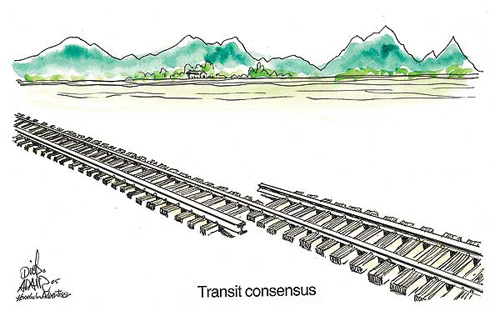
![]() February 10, 2005.
February 10, 2005.
Reps.
Mark Moses and Galen Fox support rail tax
In
House Transportation Committee votes this week Moses voted for the
county tax and Fox did not vote. However, Fox has stated his pro-rail
views on many occasions and in conversation with us 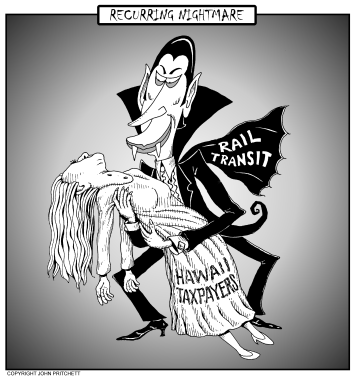 today
Fox said that he would have voted for the motion had he been there
and will do so at the next opportunity. Both Republicans Fox and
Moses have signed the Americans for Tax Reform "pledge to all
the people of this state that I will oppose and vote against any
and all efforts to increase taxes." Fox's excuse is that he
is not voting for a tax but rather for the counties ability to impose
a tax. We have said before that to give the counties that ability
without requiring a commensurate decrease in state taxes is, quite
simply, a vote for a tax increase. Fox and Moses are, to understate
it, a disappointment. Let's hope their constituents take note.
today
Fox said that he would have voted for the motion had he been there
and will do so at the next opportunity. Both Republicans Fox and
Moses have signed the Americans for Tax Reform "pledge to all
the people of this state that I will oppose and vote against any
and all efforts to increase taxes." Fox's excuse is that he
is not voting for a tax but rather for the counties ability to impose
a tax. We have said before that to give the counties that ability
without requiring a commensurate decrease in state taxes is, quite
simply, a vote for a tax increase. Fox and Moses are, to understate
it, a disappointment. Let's hope their constituents take note.
If only these legislators understood the problem as well as John Pritchett in this week's Honolulu Weekly.
![]() February 9, 2005.
February 9, 2005.
Advertiser:
"Rail tax could cost a family $900 more."
Today's Advertiser headline is for a story by Mike Leidemann
and said that sentiment in an informal poll was running 10 to 1
opposed to a tax hike. READ THE STORY
House
and Senate ready tax increase for rail transit
House
bill 1309 and Senate bills 1731 and 1366 were approved by their
respective transportation committees yesterday. They call for allowing
the counties to hike the G.E. tax by one percent to be used
for rail transit and specifically excludes its use to "repair
public roads," in other words, potholes.
OUR OPINION:
First, if you can't fix potholes what is with this "home rule"
excuse to raise taxes? Read the bills, if you must HB1309 SB1366
SB1731
Second,
the tax increase is not necessary. We can provide greater capacity
for public transportation with a HOTway and no new tax would be
needed. See Answer above.
Third, we must all remember
that anyone favoring a tax hike for the counties without providing
for a commensurate state tax decrease is, by definition, favoring
a tax hike. Period.
Fourth , the 1 percent tax hike raising $300
million annually is not enough; that only covers the capital costs;
legislators forgot the increase in annual operating costs. The 1992
rail transit proposal called for a $45 million increase annually
in operating costs (FEIS, S-25) over that of TheBus. In today's
money that is $57 million annually. All this is before the inevitability
of cost overruns for both capital costs and operating costs.
Fifth,
a one percent increase from 4 to 5 percent in the G.E. tax is a
25 percent hike in the tax we will actually pay.
![]() February 6, 2005.
February 6, 2005.
Why
are they using Vancouver as an example?
Lately
elected officials have been citing Vancouver's Sky Train as a system
that would be right for Honolulu. Of all the rail systems in the
U.S. is there not one they could cite? For them the advantage of
using Vancouver is that the data available and the definitions of
terms are different than in the U.S. It makes it easier to get away
with "misspeaking." They can hardly use Portland (see
below). See also the WSJ article below.
Lee
Cataluna has the last word on 'visioning':
It's
a funny column. She says, "It has become akin to profanity."
READ IT
WSJ:
Why we can believe what is patently untrue.
"People Believe a 'Fact'
That Fits Their Views Even if It's Clearly False,"
the Wall Street Journal tells us in their Science column on Friday.
They summarize with, "The findings also offer Machiavellian possibilities for politicians. They can
make a false claim that helps their cause, contritely retract it -- and rest
assured that some people will nevertheless keep thinking of it as true."
WSJ must be talking about the rail transit issue. READ THE COLUMN
Portland's
numbers don't jibe with the Census data. Z.
Z.
This is a chart from Reason
Foundation's Privatization Watch
which mirrors the Census
data on commuting.
One half of one percent of Portland's commuters go by light rail?
Does not quite fit with what we are told by transit officials.
![]() February 1, 2005.
February 1, 2005.
Zipper
lane extension to be completed by summer.
This is self explanatory but READ
THE FULL STORY
and
click on the map for a larger version.
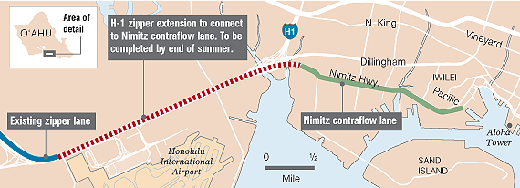
![]() January 29, 2005.
January 29, 2005.
Star-Bulletin
headlines rail tax increase:
They
say, "Rail transit tax increase
gets political momentum: Federal and local lawmakers
agree to revisit funding options."
There are bills in both houses to increase the G.E. tax "by
up to one percent." Most likely appears giving the counties
taxing authority and Honolulu would then impose a one percent county
G.E. tax. READ
THE FULL STORY
OUR
OPINION:
We should ensure that voters understand that if the state legislature
allows the counties to raise taxes without there being a commensurate
reduction in the state G.E. tax, then that is a net
tax increase,
no matter which way they try to spin it.
![]() January 27, 2005.
January 27, 2005.
Mayor
Hanneman's plan for traffic
Revealed
in the January Small Business Hawaii News that the Mayor will look
into "redoing portions of Kuhio Avenue and the Ala Wai according
to recommendations from the emergency response personnel and bus
drivers." READ
FULL STORY.
Star-Bulletin's
Borecca on the push for rail:
Says
Rep. Abercrombie pushing hard for rail through having the Legislature
allow the counties to raise the excise tax. Abercrombie is dismissing
opponents as members of "The Flat Earth Society."
READ
THE FULL STORY
OUR
OPINION: Dismissing HOT lanes, the favored mode of the federal
government, as "Flat Earth" says more about our hirsute
Congressman than it does about us.
New
SAFETEA legislation to allow more highway tolls:
SAFETEA's
Sections 1615 on Toll Programs and 1610 on Use of HOV Lanes, expands
the allowable use of tolled lanes of federally funded highways
and, most importantly, variable pricing as a way to deal with traffic
congestion. READ
THESE SECTIONS.
Gov's
State of the State speech on traffic:
She
said, "Mayor Hannemann and I
have been supporters of mass transit on O`ahu." Notice that there is no
mention of rail, or "fixed rail mass transit." "Mass
transit" used alone is defined by the federal government as
publicly accessible vehicles used for carrying unassociated riders.
Regular buses, private buses, jitney buses, and shared-ride taxis
all qualify as "mass transit." READ
THE SPEECH
Public
Roads Magazine discusses "Managed Lanes":
The
November/December issue of the FHWA's bi-monthly magazine had a
great article, "Managed Lanes: Combining access control, vehicle eligibility, and pricing strategies can
help mitigate congestion and improve mobility on the Nation's busiest roadways."
READ
THE ARTICLE.
![]() January 18, 2005.
January 18, 2005.
Rail:
Star-Bulletin wants it because it wants it."
Today's
Star-Bulletin editorial tells us they want rail transit really badly.
They don't tell us why. They don't make any arguments about if it
works (?) in other cities — or doesn't. They just really want it.
Oh, well. READ
IT IF YOU MUST
At
least Corky and Memminger get it:
Charles
Memminger talks about how Souki's demand to limit the number of
cars through punitive action will hurt the little guy READ
IT, and Corky's
take is below: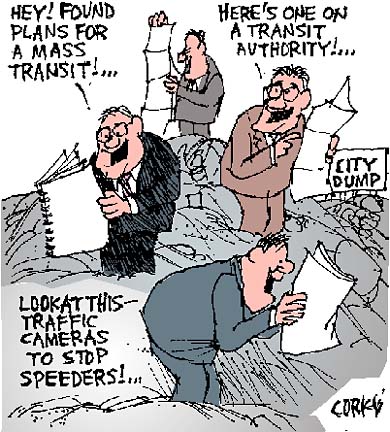
Tomorrow
at Kailua Chamber of Commerce luncheon.
Tomorrow,
Wednesday at noon, at Mid Pacific Country Club, one of our speakers,
Cliff Slater, will make the case against 'light' rail and the case
for elevated reversible HOT lanes. See another discussion of that
issue above. The public is welcome but call Kelika Ishole at 261-4947
for reservations.
Leidemann
discusses rail in legislature
"When the
state Legislature begins its annual session tomorrow, transportation is expected
to be one of the hot topics. Everybody wants somebody to do something —
anything! — to give us all a little traffic relief." He believes that "the
best
bets at this point are that legislators will probably give counties the
authority to raise their own taxes or create a special transportation authority,
which could have power to raise its own money."
OUR OPINION:
Opponents should start emailing their entire email list referring
people to this website and particularly the rail page at: http://www.honolulutraffic.com/rail_hotway.htm
If
legislators approve funding for a rail line that will be the end
of highway improvements since rail will need all the funds legislators
can get their hands on.
![]() January 17, 2005.
January 17, 2005.
Legislature
to raise taxes for rail.
"Traffic
speeds onto agenda," headlines the Star-Bulletin today. Veteran
Capitol Reporter Richard Borreca reports that "is not whether
Honolulu needs mass transit but how it will be funded. There are
two main ideas: either let the Honolulu City Council raise the excise
tax, or form a transit authority with the power to raise funds."
Rep. Joe Souki predicts, "There will be legislation to permit
the counties to raise taxes for mass transit ... It will pass the
House and Senate." Senate President Bunda says there is already
agreement to give taxing authority to the counties. FULL
STORY
OUR
OPINION: The tragedy
is that our legislators cannot point to a single U.S. rail line
that has been successful in curbing auto traffic. In fact, since
rail projects suck up all of a community's transportation moneys,
there is little left to improve roads. This is why metropolitan
areas with rail have experienced greater increases in traffic congestion
than those without. For example, out of 47 metro areas of our size,
less than 1 million population, only one has a rail line, Salt Lake
City, and it has experienced the third worst increase in traffic
congestion.
What is it with our legislators that they want
us to commit fiscal suicide?
![]() January 7, 2005.
January 7, 2005.
Strange
happenings in federal funding?
Yesterday
we revealed Tom Downs' October speech and now Reason's
Surface Transportation Newsletter for January
has this quote:
“Highways in the U.S. are traditionally government planned, government
funded, and government maintained. . . . But that is changing. The
time has come for us to acknowledge that building a highway network
is not substantially different than building a telecommunications
network or a network for the delivery of electricity. . . . The
time has come for us to allow – unleash – the private sector to
participate in all elements of infrastructure improvements. It is
time to let the free market deliver the innovation, the cost savings,
and the quality it has delivered in other industries. And, it is
time to allow the states to expand the pricing of their highway
networks. We know PPPs work. The time is right to move them into
the mainstream of transportation finance.” --Mary Peters, Federal
Highway Administrator, speaking at ARTBA Public-Private Ventures
conference, Dec. 9, 2004.
![]() January 6, 2005.
January 6, 2005.
Transportation
funding back to the states?
Just coming to light is an
October speech by Tom Downs, suggesting, "It is time to seriously look at the possibility
that we need to devolve all surface transportation funding out of Washington."
It is a carefully crafted argument emphasing the disintegration
of the federal program and a real decline in gas tax collections.
Downs is
not a lonely voice out there but rather he is the consummate Washington
insider. He is currently, Director of the
![]() January 4, 2005.
January 4, 2005.
Freight
stalls in Portland's traffic congestion.
The
Portland Tribune tells of the delays that traffic congestion is
causing business. The congestion increases are the result of neglect
in increasing and maintaining the highway system. As the Port of
Oakland's transportation manager puts it, "Policymakers are
responsive to their constituents, and freight doesn't vote."
Voters do not understand the connection between stalled freight
and increasing prices. FULL STORY
(Thanks for the tip-off to http://americandreamcoalition.org).
![]() January 3, 2005.
January 3, 2005.
Cartoonist
John Pritchett right on rail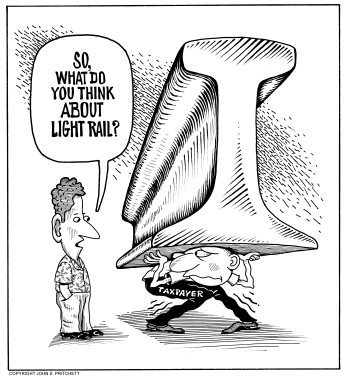
We must always remind voters that, by definition, rail proponents favor a tax increase to finance it — there is no other way to do it. PRITCHETT'S RAIL CARTOONS
![]() January 1, 2005.
January 1, 2005.
Ed
Hirata, DTS Director prioritizes rail transit.
According
to this
morning's Star-Bulletin
Mayor Hannemann's new appointment to be head of the City's transportation
department is quoted as saying, "We need to get started on
the rail project." Hirata was Governor Waihee's DOT Director
during the last rail battle and has had a long association, as both
an officer and registered lobbyist, with
Hawaiian Electric (HECO), which would be a prime beneficiary of a rail
line. Hirata will serve at least six months while Hannemann searches for
a permanent director. The Bulletin reports that, "Besides getting the ball rolling on rail, Hirata will also assist Hannemann
in implementing short-term traffic solutions such as better synchronization of
traffic signals and possibly merging the state and city traffic management
centers."



